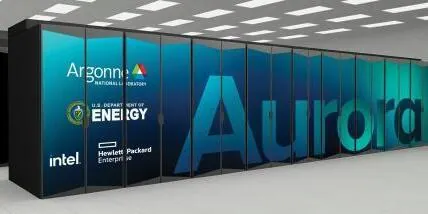
Groundbreaking Aurora Exascale Supercomputer Now Open for Global Research: What You Need to Know!
2025-01-28
Author: Ming
Introduction
The Argonne National Laboratory, part of the U.S. Department of Energy (DOE), has officially launched its highly anticipated Aurora exascale supercomputer, making it available to researchers worldwide. Designed to revolutionize the way we approach complex scientific inquiries, Aurora is tailored for advanced simulations, artificial intelligence applications, and massive data analyses.
Ranking as the third most powerful system on the Top500 list, Aurora is set to support cutting-edge research in multiple fields, including aerospace engineering, cosmology, pharmaceutical development, and nuclear energy. Michael Papka, director of the Argonne Leadership Computing Facility (ALCF), expressed excitement over the deployment, commenting, "We’re ecstatic to officially deploy Aurora for open scientific research. Early users have already hinted at Aurora’s immense potential, and we are eager to witness how researchers will leverage this powerhouse to transform their disciplines."
What Sets Aurora Apart?
Aurora is among the first of its kind; alongside its peers Frontier and El Capitan, it represents a new era in high-performance computing. Aurora's capabilities extend beyond just speed; it has recently topped the HPL-MxP benchmark for artificial intelligence performance. This makes it an essential tool for researchers looking to innovate, such as developing new battery materials, creating advanced pharmaceuticals, or speeding up fusion energy studies.
Rick Stevens, Argonne's associate lab director for Computing, Environment, and Life Sciences, highlighted one of Aurora's primary roles: "A significant aim for Aurora is training large language models for scientific applications. For instance, through the AuroraGPT project, we’re constructing a science-focused foundation model that can process and disseminate knowledge across numerous fields like biology and chemistry. Our goal is to enable researchers to generate breakthroughs as rapidly as possible, paralleling the pace of their cognitive processes."
High-Caliber Research and Real-World Impact
Initial research projects utilizing Aurora include highly sophisticated simulations of various systems, such as the human circulatory system, nuclear reactors, and supernova explosions, aimed at unraveling their intricate behaviors. Aurora's immense processing power will serve as a vital asset in analyzing voluminous data streams from major research initiatives, including data from Argonne’s Advanced Photon Source and CERN’s Large Hadron Collider.
Katherine Riley, ALCF's director of science, emphasized the significance of projects running on Aurora. "These projects embody some of the most ambitious and innovative scientific endeavors today. From the modeling of intricate physical systems to managing vast datasets, Aurora will accelerate discoveries that broaden our understanding of the universe."
A Remarkable Engineering Feat
The deployment of Aurora represents the culmination of extensive collaboration among top-tier technology partners, including Intel and Hewlett Packard Enterprise (HPE). With an infrastructure that features 63,744 graphics processing units and 84,992 network endpoints, Aurora is not just a supercomputer; it’s a monumental engineering accomplishment. Stretching over eight rows of refrigerator-sized cabinets, this colossal machine weighs an astonishing 600 tons and covers an area equivalent to two professional basketball courts.
The implementation of Aurora involved innovative technologies and meticulous planning to address challenges inherent in such a large-scale system. Susan Coghlan, ALCF project director, noted that crafting a system of this magnitude required new strategies and collaborative efforts on an unprecedented scale.
Accelerating Science from Day One
Thanks to a co-design development process, Aurora's scientific software and hardware were optimized concurrently, assuring that the machine would be production-ready upon deployment. With rigorous testing and the optimization of multiple scientific applications already underway, over 70 diverse projects are currently underway—including those from the ALCF’s Early Science Program and two major allocation programs.
As Aurora enters full operational status, the scientific community anticipates significant advancements fueled by this powerful resource. From elucidating fundamental scientific questions to pioneering technological innovations, Aurora stands poised to reshape the landscape of computational research and human understanding.
Keep an eye on this transformational supercomputer—its potential to propel groundbreaking discoveries is just beginning!
 Brasil (PT)
Brasil (PT)
 Canada (EN)
Canada (EN)
 Chile (ES)
Chile (ES)
 Česko (CS)
Česko (CS)
 대한민국 (KO)
대한민국 (KO)
 España (ES)
España (ES)
 France (FR)
France (FR)
 Hong Kong (EN)
Hong Kong (EN)
 Italia (IT)
Italia (IT)
 日本 (JA)
日本 (JA)
 Magyarország (HU)
Magyarország (HU)
 Norge (NO)
Norge (NO)
 Polska (PL)
Polska (PL)
 Schweiz (DE)
Schweiz (DE)
 Singapore (EN)
Singapore (EN)
 Sverige (SV)
Sverige (SV)
 Suomi (FI)
Suomi (FI)
 Türkiye (TR)
Türkiye (TR)